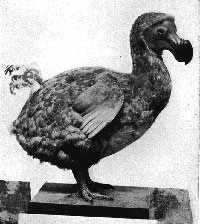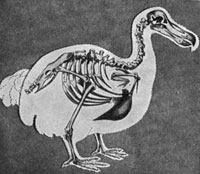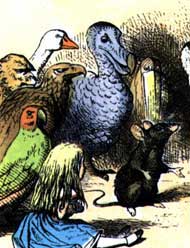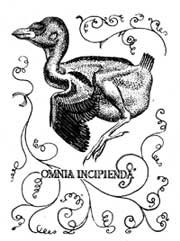|

 Weights and Measures: The decaying remnants of the last complete stuffed Dodo, in Oxford's Ashmolean Museum, was ordered burned by the museum's director in 1755; the foot and head were salvaged from this specimen, and are currently on display. Weights and Measures: The decaying remnants of the last complete stuffed Dodo, in Oxford's Ashmolean Museum, was ordered burned by the museum's director in 1755; the foot and head were salvaged from this specimen, and are currently on display.
Nevertheless, from artists' renditions we know that the Dodo had blue-grey plumage, a
23-centimetre (9-inch) blackish hooked bill with a reddish point, very small useless
wings, stout yellow legs, and a tuft of curly feathers high on its rear end. Dodos were
very large birds, weighing about 23 kg
(50 pounds).
New, Sleek Dodo: The traditional image of the Dodo is of a fat, clumsy bird, but this view has been challenged by Andrew Kitchener, a biologist at the Royal Museum of Scotland (reported in National Geographic News, February 2002), who believes that the old drawings showed overfed captive specimens. As Mauritius has marked dry and wet seasons, the Dodo probably fattened itself on ripe fruits at the end of the wet season to live through the dry season where food was scarce; contemporary reports speak of the birds' "greedy" appetite. Thus, in captivity with food readily available, the birds would become overfed very easily.

 Long Gone: The source of the dodo's extinction is not certain, but recent evidence suggests that it was nearly wiped out by Long Gone: The source of the dodo's extinction is not certain, but recent evidence suggests that it was nearly wiped out by
some natural disaster before humans even arrived on the island, its population reduced so severely that it fell below sustainable levels.
Feathered and Fearless: As with many animals evolving in isolation from significant predators, the Dodo was entirely fearless
of people, and this, in combination with
its flightlessness, made it easy prey.
(The island was first visited by the Portuguese in 1505, but the Dutch were the first permanent settlers on the island.)
Alien Invaders: However, when humans first arrived on Mauritius, they also brought with them other animals that had not existed on the island before, including sheep, dogs, pigs, rats and monkeys, which plundered the Dodo nests, while humans destroyed the forests where they made their homes.
Extinction Date Debate: There is some controversy surrounding the extinction date of the Dodo. David Roberts states that "the extinction of the Dodo is commonly dated to the last confirmed sighting in 1662, reported by shipwrecked mariner Volkert Evertsz", but other sources suggest 1681.
 Roberts points out that because the sighting prior to 1662 was in 1638 (i.e. 24 years earlier), the Dodo was likely already very rare by the 1660s. However, statistical analysis of the hunting records of Isaac Joan Lamotius, carried out by Julian Hume and coworkers, gives a new estimated extinction date of 1693, with a 95% confidence interval of 1688 to 1715. Roberts points out that because the sighting prior to 1662 was in 1638 (i.e. 24 years earlier), the Dodo was likely already very rare by the 1660s. However, statistical analysis of the hunting records of Isaac Joan Lamotius, carried out by Julian Hume and coworkers, gives a new estimated extinction date of 1693, with a 95% confidence interval of 1688 to 1715.
Alice in Wonderland: No one took particular notice of the extinct bird until it was featured
in the Caucus race in Lewis Carroll's Alice's Adventures in Wonderland (1865). With the popularity of the book, the Dodo became
a household word: "as dead as a Dodo".
The character was named Dodo.

Pigeon Cousins: The last known Dodo was killed less than 100 years after the species' discovery, and no complete specimens are preserved, although a number of museum collections contain Dodo skeletons. A Dodo egg is on display at the East London museum in South Africa. Genetic material has been recovered from these and its analysis has confirmed that the Dodo was a close relative of pigeon species that are to be found in Africa and especially South Asia.
The Name Game: The origin of the word 'Dodo' is not clear. It may be related to the Dutch word "dodaars" the name of the little Grebe or Dabchick in the Dutch language. The connection may have been made because of similar feathers on the hind end, or because both animals were clumsy walkers.
However, the Dutch are known to have called the bird the "walgvogel" ("terrible bird") in reference to its taste. Against this thesis plays also the fact that "dodo" is attested in English since 1628, when the Dutch did not arrive to Mauritius before 1638.
According to Encarta Dictionary and Chambers Dictionary of Etymology, "dodo" comes from Portuguese doudo (currently, more often, doido) meaning "fool" or "crazy".  The present Portuguese word dodô ("dodo") is of English origin. The Portuguese word doudo or doido may itself be a loanword from Old English (cp. English "dolt"). The present Portuguese word dodô ("dodo") is of English origin. The Portuguese word doudo or doido may itself be a loanword from Old English (cp. English "dolt").
Yet another possibility, as author David Quammen has noted in his book "Song of the Dodo", "that 'dodo' was an onomatopoeic approximation of the bird's own call, a two-note pigeony sound like 'doo-doo'."
Dodo Discovery: In October, 2005, an important site of Dodo remains was found by Dutch researchers in Mauritius, including birds of various stages of maturity. These findings were made public in December 2005 in the Naturalis in Leiden. Before this find, few Dodo specimens were known. Dublin's Natural History Museum had an assembled specimen, while the most intact remains from a single bird are a skeletal foot and a head, which contains the only known soft tissue remains of the species.
All text is available under the terms
of the GNU Free Documentation License
|